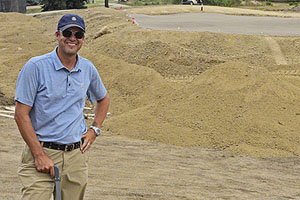As trends in the golf industry shift - namely fewer people playing on a shrinking number of courses, heavily scrutinized management practices and a labor crunch, and no end in sight for any of it - golf course architecture too must take a different path.
 Golf course architect Andy Staples is out to change the way people view the game. He believes factors like courses that are shorter than 18 holes, have few if any hazards and are easier to maintain and traits like compelling design don't have to be mutually exclusive.
Golf course architect Andy Staples is out to change the way people view the game. He believes factors like courses that are shorter than 18 holes, have few if any hazards and are easier to maintain and traits like compelling design don't have to be mutually exclusive.
In fact, the concept that a good golf course has to fit a certain template and level of difficulty is a tradition as old as the game itself, and it is a hurdle that comes up in conversation so often, it makes Staples laugh when asked about it.
"I hear it all the time," said Staples, principal of Scottsdale-based Staples Golf Design. "The perception is that a course that is built in a sustainable manner and is easy to maintain either is a lower-tier course, or you can't afford to maintain it."
Sustainable and compelling design that minimizes time spent on maintenance, mowing and inputs and reduces water and energy consumption can help grow the game, Staples says.
"I believe design matters; architecture matters," he said. "I believe compelling, interesting architecture compels people to play more. Years ago, just the game itself brought people out to the golf course. It's not that way anymore. Compelling design that is easily maintained is what golfers find appealing."
It also is what the industry desperately needs, says Staples.
Golf course superintendents from coast to coast are struggling to find and retain labor. Golf courses are competing with and losing to retail outlets and restaurants for labor. The situation is even worse in states where mandated raises in the minimum wage are underway.
High school students once lined up for golf course jobs thanks to the allure of free golf and working outdoors. Now, it's the job no one wants.
Golfer demand and scrutinized maintenance practices from those outside the industry who don't know and don't want to know what happens inside the ropes often are at odds with each other. Access to adequate water supplies is a real issue in much of the country and it's a challenge that is not going away.

Staples got his start in the business with Wadsworth Golf Construction and has owned his own design firm since 2002. Today when he meets with decision makers at daily fee courses and private clubs on projects such as master plans, renovations and total rebuilds, he brings up alternative to traditional golf course design like 12-hole designs, removing bunkers or eliminating them entirely and for those who decide to keep them, changing the design to reduce maintenance time spent in bunkers or on the faces of them.
His firm boasts more than 100 projects varying in size and scope, and he implements a sustainable design philosophy in all of them, including elements that support water and fuel efficiency and require minimal maintenance input.
One project currently underway in Arizona, the golf course once had 60 bunkers totalling more than 90,000 square feet. Today, the same course has 58 bunkers occupying just 60,000 square feet. That's a reduction of more than 30 percent.
"I tried to have several holes with no bunkers at all, but the members saw that idea and said 'there has to be something.' " he said.
He hopes one day he can convince people that it's OK to have a golf course with no bunkers at all.
"I have one project now going on that has just seven bunkers and some transition areas," he said.
"It's not an easy conversation. My dream is to have a client that allows me to design a course with no bunkers."
Although no one has taken him up on the idea of a bunker-free golf course, Staples has not lost hope.
"Every property is unique and different," he said. "Conversations with owners and superintendents are getting easier. Now, they're actually expecting a philosophy around water conservation and energy efficiency, things we never got into years ago. Now, the No. 1 issue on everyone's list is labor. We're trying to reduce bunker quantity and maintenance and we're think about interest rather than putting mindless bunkers in everywhere.
"In my business today as opposed to when I first started, we were not having these conversations. We were ignoring them. I never had a sit down with a senior group of players on a Tuesday afternoon after their round. Now, I'm having those kinds of meetings all the time, communicating, educating and building trust."


